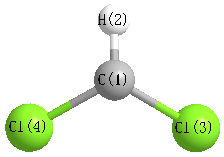Jump to
S1C2
Energy calculated at QCISD(T)=FULL/aug-cc-pVTZ
| | hartrees |
|---|
| Energy at 0K | -958.132535 |
| Energy at 298.15K | |
| HF Energy | -957.449324 |
| Nuclear repulsion energy | 126.187728 |
The energy at 298.15K was derived from the energy at 0K
and an integrated heat capacity that used the calculated vibrational frequencies.
Vibrational Frequencies calculated at QCISD(T)=FULL/aug-cc-pVTZ
| Mode Number |
Symmetry |
Frequency
(cm-1) |
Scaled Frequency
(cm-1) |
IR Intensities
(km mol-1) |
Raman Act
(Å4/u) |
Dep P |
Dep U |
|---|
| 1 |
A1 |
3319 |
3319 |
|
|
|
|
| 2 |
A1 |
760 |
760 |
|
|
|
|
| 3 |
A1 |
309 |
309 |
|
|
|
|
| 4 |
B1 |
354i |
354i |
|
|
|
|
| 5 |
B2 |
1238 |
1238 |
|
|
|
|
| 6 |
B2 |
942 |
942 |
|
|
|
|
Unscaled Zero Point Vibrational Energy (zpe) 3106.8 cm
-1
Scaled (by 1) Zero Point Vibrational Energy (zpe) 3106.8 cm
-1
See section
III.C.1 List or set vibrational scaling factors
to change the scale factors used here.
See section
III.C.2
Calculate a vibrational scaling factor for a given set of molecules
to determine the least squares best scaling factor.
Geometric Data calculated at QCISD(T)=FULL/aug-cc-pVTZ
Point Group is C2v
Cartesians (Å)
| Atom |
x (Å) |
y (Å) |
z (Å) |
|---|
| C1 |
0.000 |
0.000 |
0.672 |
| H2 |
0.000 |
0.000 |
1.739 |
| Cl3 |
0.000 |
1.470 |
-0.170 |
| Cl4 |
0.000 |
-1.470 |
-0.170 |
Atom - Atom Distances (Å)
| |
C1 |
H2 |
Cl3 |
Cl4 |
| C1 | | 1.0678 | 1.6939 | 1.6939 |
H2 | 1.0678 | | 2.4096 | 2.4096 | Cl3 | 1.6939 | 2.4096 | | 2.9403 | Cl4 | 1.6939 | 2.4096 | 2.9403 | |
 More geometry information
More geometry information
Calculated Bond Angles
| atom1 |
atom2 |
atom3 |
angle |
|
atom1 |
atom2 |
atom3 |
angle |
| Cl3 |
C1 |
H2 |
119.782 |
|
Cl3 |
C1 |
Cl4 |
120.437 |
| Cl4 |
C1 |
H2 |
119.782 |
|
Electronic energy levels
Charges, Dipole, Quadrupole and Polarizability
Jump to
S1C1
Energy calculated at QCISD(T)=FULL/aug-cc-pVTZ
| | hartrees |
|---|
| Energy at 0K | -958.133219 |
| Energy at 298.15K | -958.134013 |
| HF Energy | -957.450885 |
| Nuclear repulsion energy | 126.047032 |
The energy at 298.15K was derived from the energy at 0K
and an integrated heat capacity that used the calculated vibrational frequencies.
Vibrational Frequencies calculated at QCISD(T)=FULL/aug-cc-pVTZ
| Mode Number |
Symmetry |
Frequency
(cm-1) |
Scaled Frequency
(cm-1) |
IR Intensities
(km mol-1) |
Raman Act
(Å4/u) |
Dep P |
Dep U |
|---|
| 1 |
A' |
3283 |
3283 |
|
|
|
|
| 2 |
A' |
767 |
767 |
|
|
|
|
| 3 |
A' |
472 |
472 |
|
|
|
|
| 4 |
A' |
302 |
302 |
|
|
|
|
| 5 |
A" |
1245 |
1245 |
|
|
|
|
| 6 |
A" |
914 |
914 |
|
|
|
|
Unscaled Zero Point Vibrational Energy (zpe) 3491.5 cm
-1
Scaled (by 1) Zero Point Vibrational Energy (zpe) 3491.5 cm
-1
See section
III.C.1 List or set vibrational scaling factors
to change the scale factors used here.
See section
III.C.2
Calculate a vibrational scaling factor for a given set of molecules
to determine the least squares best scaling factor.
Geometric Data calculated at QCISD(T)=FULL/aug-cc-pVTZ
Point Group is Cs
Cartesians (Å)
| Atom |
x (Å) |
y (Å) |
z (Å) |
|---|
| C1 |
0.011 |
0.694 |
0.000 |
| H2 |
-0.457 |
1.657 |
0.000 |
| Cl3 |
0.011 |
-0.171 |
1.466 |
| Cl4 |
0.011 |
-0.171 |
-1.466 |
Atom - Atom Distances (Å)
| |
C1 |
H2 |
Cl3 |
Cl4 |
| C1 | | 1.0708 | 1.7026 | 1.7026 |
H2 | 1.0708 | | 2.3899 | 2.3899 | Cl3 | 1.7026 | 2.3899 | | 2.9326 | Cl4 | 1.7026 | 2.3899 | 2.9326 | |
 More geometry information
More geometry information
Calculated Bond Angles
| atom1 |
atom2 |
atom3 |
angle |
|
atom1 |
atom2 |
atom3 |
angle |
| Cl3 |
C1 |
H2 |
117.197 |
|
Cl3 |
C1 |
Cl4 |
118.912 |
| Cl4 |
C1 |
H2 |
117.197 |
|
Electronic energy levels
Charges, Dipole, Quadrupole and Polarizability
